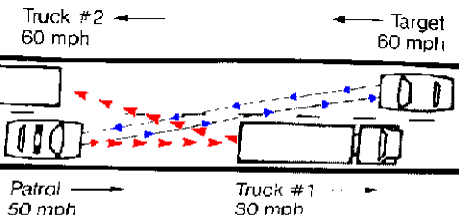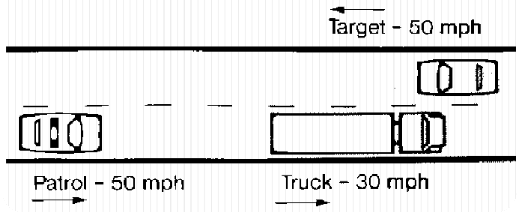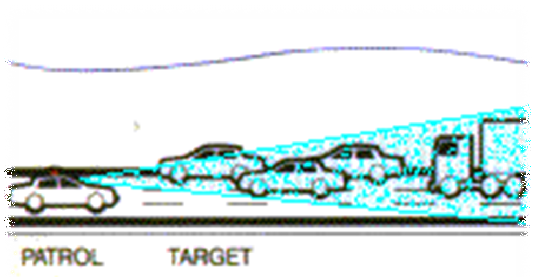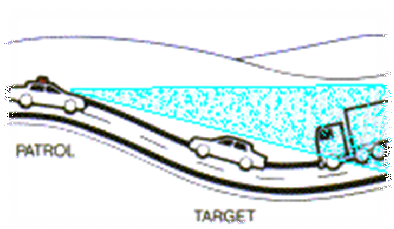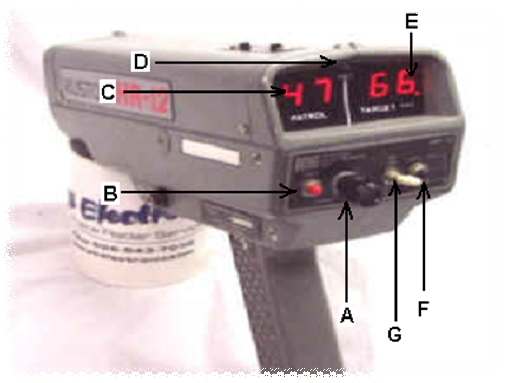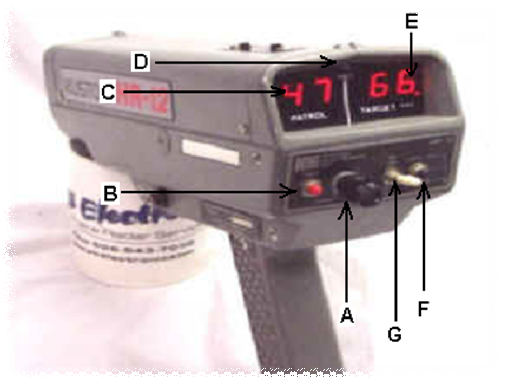Introduction To Basic Traffic Radar Theory
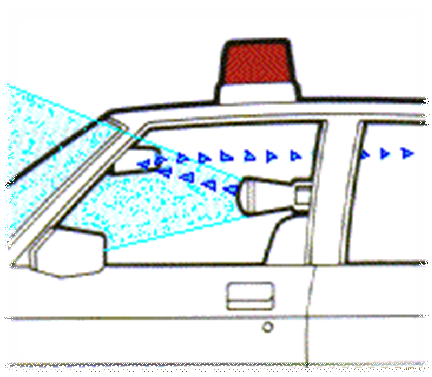
Written test for the academic portion of the RADAR certication course.
- 1.
Approximately how many reported crashes occurred in 2004?
- A.
6.1 billion
- B.
6.1 million
- C.
6.2 million
- D.
5.6 million
Correct Answer
C. 6.2 millionExplanation
In 2004, approximately 6.2 million reported crashes occurred. This indicates that there were a significant number of accidents during that year.Rate this question:
-
- 2.
When speed increases from ________, the energy released in a crash more than doubles.
- A.
30 MPH to 50 MPH
- B.
40 MPH to 50 MPH
- C.
40 MPH to 60 MPH
- D.
50 MPH to 60 MPH
- E.
None of the Above
Correct Answer
C. 40 MpH to 60 MpHExplanation
When speed increases from 40 MPH to 60 MPH, the energy released in a crash more than doubles. This is because the kinetic energy of an object is directly proportional to the square of its velocity. Therefore, even a small increase in speed can result in a significant increase in energy.Rate this question:
-
- 3.
How many drivers will get a speeding ticket this year?
- A.
One in every 5
- B.
One in every 6
- C.
Two in every 5
- D.
Two in every 6
Correct Answer
B. One in every 6Explanation
One in every 6 drivers will get a speeding ticket this year because the answer option states that "one in every 6" will receive a ticket. This means that out of every 6 drivers, only one will be issued a speeding ticket.Rate this question:
-
- 4.
Based on the slide presentation, which state was not listed in the top 10 states notorious for writing traffic tickets?
- A.
Georgia
- B.
New York
- C.
North Carolina
- D.
South Carolina
- E.
Massachusetts
Correct Answer
D. South CarolinaExplanation
South Carolina was not listed in the top 10 states notorious for writing traffic tickets according to the slide presentation.Rate this question:
-
- 5.
What section of the U.S. Code do VA Police Officers receive their authority?
- A.
Title 30 U.S.C. sections 901 & 902
- B.
Title 38 U.S.C. sections 901 & 902
- C.
Title 38 U.S.C. sections 911 & 912
- D.
Title 30 U.S.C. sections 801 & 802
Correct Answer
B. Title 38 U.S.C. sections 901 & 902Explanation
VA Police Officers receive their authority from Title 38 U.S.C. sections 901 & 902.Rate this question:
-
- 6.
VA regulations 38 C.F.R. _______ dictates the Schedule of Offenses and Penalties enforced on VA property.
- A.
§1218(b)
- B.
§1.208(b)
- C.
§1.218(a)
- D.
§1.218(b)
Correct Answer
D. §1.218(b)Explanation
VA regulations 38 C.F.R. §1.218(b) specifically outlines the Schedule of Offenses and Penalties enforced on VA property. This regulation provides the guidelines and rules for what offenses are considered violations and the corresponding penalties that will be enforced. It is important for individuals to be aware of and adhere to these regulations when on VA property to ensure a safe and compliant environment.Rate this question:
-
- 7.
What sub-section is speeding found on the Schedule of Offenses and Penalties?
- A.
Section (32)
- B.
Section (33)
- C.
Section (34)
- D.
Section (35)
Correct Answer
C. Section (34) -
- 8.
On the ‘Offense Description’ portion of the UDSC, what information pertaining to the RADAR Unit needs to appear in the left side of the block?
- A.
Location of the violation
- B.
"Exceeding Posted Speed Limits" statement
- C.
IOCD, Make, Model and Serial Number of the RADAR
- D.
RADAR operator's certification number
Correct Answer
C. IOCD, Make, Model and Serial Number of the RADARExplanation
The information that needs to appear in the left side of the block on the 'Offense Description' portion of the UDSC is the IOCD (Initials of the Charging Officer and Department), Make, Model, and Serial Number of the RADAR. This information is important for accurately identifying and documenting the RADAR unit used in the offense. The RADAR operator's certification number is not mentioned in the question and therefore is not required to appear in the left side of the block.Rate this question:
-
- 9.
What form should be used if issuing a written warning for a violation?
- A.
VA Form 6160 Courtesy Warning Notice
- B.
VA Form 6160 Courtesy Violation Notice
- C.
VA Form 6150 Courtesy Warning Notice
- D.
MVP 512 Written Warning Notice
Correct Answer
B. VA Form 6160 Courtesy Violation NoticeExplanation
The correct form to be used when issuing a written warning for a violation is VA Form 6160 Courtesy Violation Notice.Rate this question:
-
- 10.
According to the NHTSA, what persentage of all motorcycle deaths were contributed to speeding in 2002?
- A.
35 Percent
- B.
36 Percent
- C.
38 Percent
- D.
39 Percent
Correct Answer
C. 38 PercentExplanation
In 2002, the NHTSA reported that 38 percent of all motorcycle deaths were caused by speeding. This means that a significant portion of motorcycle fatalities were a result of exceeding the speed limit. It highlights the importance of adhering to speed limits and practicing safe driving habits to prevent accidents and fatalities on the road.Rate this question:
-
- 11.
What year did Christian Doppler first come up the theory that the frequency of sound waves change in relationship to movement?
- A.
1832
- B.
1839
- C.
1842
- D.
1849
Correct Answer
C. 1842Explanation
Christian Doppler first came up with the theory that the frequency of sound waves changes in relation to movement in the year 1842.Rate this question:
-
- 12.
Radio waves travel at 186,000 miles per second (mps).
- A.
True
- B.
False
Correct Answer
A. TrueExplanation
Radio waves travel at 186,000 miles per second (mps). This statement is true. Radio waves are a type of electromagnetic radiation that can travel through space at the speed of light, which is approximately 186,000 miles per second. This speed allows radio waves to quickly propagate over long distances, making them ideal for communication purposes.Rate this question:
-
- 13.
When the observer moves with the same velocity towards or away from the stationary source, this type of effect is referred to as ___________.
Correct Answer
symmetrical
SYMMETRICAL
SymmetricalExplanation
When the observer moves with the same velocity towards or away from the stationary source, the effect is referred to as symmetrical. This means that the observer and the source are moving in opposite directions with the same speed, resulting in a symmetrical pattern of sound waves.Rate this question:
- 14.
RADAR technology is based on the laws of physics and was first developed shortly before World War II by what country?
- A.
Belgium
- B.
France
- C.
Britain
- D.
United States
Correct Answer
C. BritainExplanation
RADAR technology was first developed by Britain shortly before World War II. This technology is based on the laws of physics, specifically the principle of sending out radio waves and detecting their reflection off objects to determine their location and speed. Britain's development of RADAR played a significant role in their defense strategy during the war, allowing them to detect and track enemy aircraft and ships.Rate this question:
-
- 15.
When the source of sound moves towards or away from an observer causing an apparent shift in frequency, this type of effect is referred to as __________.
Correct Answer
asymmetrical
ASYMMETRICAL
AsymmetricalExplanation
The given correct answer is "asymmetrical". When the source of sound moves towards or away from an observer, it causes a change in frequency due to the Doppler effect. This effect is referred to as "asymmetrical" because the change in frequency is not the same when the source moves towards or away from the observer.Rate this question:
- 16.
There is no Doppler effect when the source or listener is at the center of a circle while the other is moving around the circle at a ___________ speed.
Correct Answer
uniform
constantExplanation
When the source or listener is at the center of a circle and the other is moving around the circle at a uniform, constant speed, there is no Doppler effect. This is because the distance between the source and listener remains constant, resulting in no change in frequency or wavelength of the sound waves. The Doppler effect occurs when there is relative motion between the source and listener, causing a shift in frequency due to the compression or expansion of sound waves. However, in this scenario, the uniform, constant speed ensures that there is no change in the relative motion, hence no Doppler effect.Rate this question:
- 17.
The term "RADAR" is an acronym that stands for ___________.
Correct Answer
Radio Detection and RangingExplanation
The term "RADAR" is an acronym that stands for Radio Detection and Ranging. This technology uses radio waves to detect and locate objects, as well as determine their distance and speed. It works by emitting radio waves and then measuring the time it takes for the waves to bounce back after hitting an object. This acronym accurately describes the fundamental principles and purpose of RADAR.Rate this question:
- 18.
Frequency refers to the number of _________ sent out in one second.
- A.
Doppler's
- B.
Hertz (Hz)
- C.
Waves
- D.
Signals
Correct Answer
C. WavesExplanation
Frequency refers to the number of waves sent out in one second. It is a measure of how many complete cycles of a wave occur in a given time period. In this context, the correct answer is "waves" because frequency is specifically related to the number of waves. Doppler's principle, hertz (Hz), and signals are not directly related to the concept of frequency.Rate this question:
-
- 19.
A frequency often times is referred to as a _________.
- A.
Signal
- B.
Wave
- C.
Hertz (Hz)
- D.
Valley
Correct Answer
C. Hertz (Hz)Explanation
A frequency is often referred to as hertz (Hz) because hertz is the unit of measurement used to quantify the frequency of a signal or wave. It represents the number of cycles or oscillations that occur in one second. Therefore, hertz is the appropriate term to describe the frequency of a signal or wave.Rate this question:
-
- 20.
A traffic RADAR beam can transmit how many waves per second?
- A.
36 billion
- B.
46 billion
- C.
46 million
- D.
38 million
Correct Answer
A. 36 billionExplanation
A traffic RADAR beam can transmit 36 billion waves per second.Rate this question:
-
- 21.
The distance from the beginning of a peak to the bottom of a valley is one_________.
Correct Answer
wavelengthExplanation
The distance from the beginning of a peak to the bottom of a valley is one wavelength. In a wave, a wavelength is the distance between two corresponding points on the wave, such as from one peak to the next peak or from one valley to the next valley. Therefore, the correct answer is wavelength.Rate this question:
- 22.
A RADAR signal will go on for ever unless it is_________, ________ or _________.
Correct Answer
reflected refracted absorbedExplanation
A RADAR signal will go on forever unless it is reflected, refracted, or absorbed. This means that the signal will continue to travel until it encounters an object or medium that either reflects the signal back, changes its direction through refraction, or absorbs the signal completely. These three possibilities determine the fate of the radar signal and determine whether it will continue to propagate or be altered or stopped altogether.Rate this question:
- 23.
What is the range of a RADAR unit when operated in the stationary mode?
- A.
6000 feet
- B.
600 yards
- C.
10000 feet
- D.
1000 yards
Correct Answer
D. 1000 yardsExplanation
The range of a RADAR unit when operated in the stationary mode is 1000 yards.Rate this question:
-
- 24.
At what frequency does a K-Band RADAR operate?
- A.
10.525 GHz
- B.
24.15 GHz
- C.
33.4 to 36 GHz
Correct Answer
B. 24.15 GHzExplanation
A K-Band RADAR operates at a frequency of 24.15 GHz.Rate this question:
-
- 25.
The court case that ruled that the radar device was not proved to be accurate since no external test had been performed before or after the arrest.
- A.
Kentucky v. Honeycutt
- B.
People of New York v. Perlman
- C.
State of Wisconsin v. Hanson
- D.
State of Minnesota v. Gerdes
- E.
State of Delaware v. Edwards
Correct Answer
B. People of New York v. PerlmanExplanation
The given correct answer is "People of New York v. Perlman." This court case is relevant because it ruled that the radar device used in the arrest was not proven to be accurate. The lack of external testing before or after the arrest was a crucial factor in this ruling. This suggests that the court questioned the reliability of the radar device and the accuracy of the arrest based on its readings.Rate this question:
-
- 26.
This court case the court ruled that an officer is not required to know the scientific principles of radar.
- A.
Kentucky v. Honeycutt
- B.
People of New York v. Perlman
- C.
State of Wisconsin v. Hanson
- D.
State of Minnesota v. Gerdes
- E.
State of Delaware v. Edwards
Correct Answer
A. Kentucky v. HoneycuttExplanation
In the court case Kentucky v. Honeycutt, the court ruled that an officer is not required to know the scientific principles of radar. This means that an officer can still use radar to determine the speed of a vehicle without having in-depth knowledge of how the radar technology works. The ruling suggests that as long as the officer is trained on how to properly operate the radar device and interpret its readings, their lack of scientific knowledge about radar principles does not invalidate the evidence gathered using radar technology.Rate this question:
-
- 27.
In this court case the court ruled that unit must be tested with an external source, such as a tuning fork or a calibrated speedometer.
- A.
Kentucky v. Honeycutt
- B.
People of New York v. Perlman
- C.
State of Wisconsin v. Hanson
- D.
State of Minnesota v. Gerdes
- E.
State of Delaware v. Edwards
Correct Answer
D. State of Minnesota v. GerdesExplanation
In the court case State of Minnesota v. Gerdes, the court ruled that a unit must be tested with an external source, such as a tuning fork or a calibrated speedometer. This means that in order to determine the accuracy or functionality of the unit in question, it must be compared or tested against a reliable and established external source. This ruling emphasizes the importance of using objective and standardized methods to assess the performance of the unit, ensuring fair and accurate judgment in the case.Rate this question:
-
- 28.
The ten significant court cases which pertain to the use of RADAR in speed enforcement primarily address with the ________and _________ of the RADAR unit. (Select two answers)
- A.
Reliability
- B.
Functions
- C.
Accuracy
- D.
Legality
Correct Answer(s)
A. Reliability
C. AccuracyExplanation
The correct answer is reliability and accuracy. The ten significant court cases related to the use of RADAR in speed enforcement primarily focus on the reliability and accuracy of the RADAR unit. These cases likely examine the effectiveness and precision of RADAR technology in accurately measuring vehicle speeds, as well as the reliability of the equipment itself in providing consistent and trustworthy results. The legality and functions of RADAR may also be considered in these cases, but the main emphasis is on reliability and accuracy.Rate this question:
-
- 29.
During certain instances, the RADAR will generate a 'false' reading.
- A.
True
- B.
False
Correct Answer
B. FalseExplanation
During certain instances, the RADAR can generate a 'false' reading. This is because RADAR can be affected by various factors such as weather conditions, interference from other signals, or objects in the environment that may reflect or scatter the radar waves. These factors can cause the RADAR to detect objects that are not actually present or fail to detect objects that are there. Therefore, it is possible for the RADAR to produce false readings in certain situations.Rate this question:
-
- 30.
When RADAR unit produces radar readings on vehicles behind the patrol car through the rearview mirror is known as a ____________.
- A.
Shadowing Error
- B.
Antenna Positioning Error
- C.
Multiple Bounce Error
- D.
Beam Reflection Error
- E.
Look Past Error
Correct Answer
D. Beam Reflection ErrorExplanation
When RADAR unit produces radar readings on vehicles behind the patrol car through the rearview mirror, it is known as a Beam Reflection Error. This error occurs when the radar beam reflects off the rearview mirror and produces inaccurate readings.Rate this question:
-
- 31.
When several reflected near-equal strengths but varying frequencies arrive at the radar gun's antenna, this is known as__________.
- A.
Shadowing Error
- B.
Antenna Positioning Error
- C.
Multiple Bounce Error
- D.
Beam Reflection Error
- E.
Look Past Error
Correct Answer
C. Multiple Bounce ErrorExplanation
When several reflected near-equal strengths but varying frequencies arrive at the radar gun's antenna, this is known as multiple bounce error. This error occurs when the radar waves bounce off multiple objects before reaching the antenna, causing the radar gun to receive multiple reflections with similar strengths but different frequencies. This can lead to inaccurate measurements and difficulties in determining the actual target.Rate this question:
-
- 32.
When the RADAR locks onto a large moving object in front of the patrol vehicle and computes the difference in speeds between the two vehicles producing an erroneously high reading, this is known as_____________.
- A.
Shadowing Error
- B.
Antenna Positioning Error
- C.
Multiple Bounce Error
- D.
Beam Reflection Error
- E.
Look Past Error
Correct Answer
A. Shadowing ErrorExplanation
When the RADAR locks onto a large moving object in front of the patrol vehicle and computes the difference in speeds between the two vehicles producing an erroneously high reading, this is known as shadowing error.Rate this question:
-
- 33.
When the RADAR is looking past a small reflection in the foreground to read a larger reflection behind it is know as a __________.
- A.
Shadowing Error
- B.
Antenna Positioning Error
- C.
Multiple Bounce Error
- D.
Beam Reflection Error
- E.
Look Past Error
Correct Answer
E. Look Past ErrorExplanation
When the RADAR is looking past a small reflection in the foreground to read a larger reflection behind it, it is known as a Look Past Error. This error occurs when the RADAR signal is obstructed by a smaller object in the foreground, causing the RADAR to mistakenly read the reflection from the smaller object instead of the larger one behind it. This can lead to inaccurate measurements or detection of objects.Rate this question:
-
- 34.
When the patrol car is at the crest of a hill, it is very easy for RADAR to overshoot the nearest vehicle and instead take a reading from a vehicle on the next hill is known as_________.
- A.
Shadowing Error
- B.
Antenna Positioning Error
- C.
Multiple Bounce Error
- D.
Beam Reflection Error
- E.
Look Past Error
Correct Answer
B. Antenna Positioning ErrorExplanation
When the patrol car is at the crest of a hill, the position of the RADAR antenna may not be ideal for accurately detecting the nearest vehicle. This can result in the RADAR overshooting and taking a reading from a vehicle on the next hill instead. This error is known as Antenna Positioning Error.Rate this question:
-
- 35.
The fan reading will disappear when a target comes ________and will not distort the speed reading of the target vehicle.
Correct Answer
into range
in range
within rangeExplanation
The correct answer is "within range". When a target comes within range of the fan reading, it will disappear. This means that the target is close enough for the fan reading to no longer be visible. However, the speed reading of the target vehicle will not be distorted.Rate this question:
- 36.
The three main functions in trigonometry are _____, ______ and ________.
Correct Answer
sine cosine tangentExplanation
Trigonometry is a branch of mathematics that deals with the relationships between the angles and sides of triangles. The three main functions in trigonometry are sine, cosine, and tangent. Sine (sin) is the ratio of the length of the side opposite the angle to the hypotenuse. Cosine (cos) is the ratio of the length of the side adjacent to the angle to the hypotenuse. Tangent (tan) is the ratio of the length of the side opposite the angle to the side adjacent to the angle. These functions are essential in solving various trigonometric problems and are widely used in fields such as physics, engineering, and navigation.Rate this question:
- 37.
Cosine is the calculation is of one side of a triangle _______ by another side.
- A.
Added
- B.
Subtracted
- C.
Multiplied
- D.
Divided
- E.
None of the above
Correct Answer
D. DividedExplanation
The cosine of an angle in a triangle is calculated by dividing the length of one side of the triangle by the length of another side. This calculation is based on the ratio of the adjacent side to the hypotenuse in a right-angled triangle. Therefore, the correct answer is "divided".Rate this question:
-
- 38.
Based on the __________, if the RADAR is positioned at an angle to the path of the target vehicle, the apparent speed of the vehicle is always reduced.
- A.
Frequency
- B.
Cosine effect
- C.
Doppler Principle
- D.
RADAR refraction
Correct Answer
B. Cosine effectExplanation
The cosine effect refers to the phenomenon where the measured speed of a moving object is reduced when the radar is positioned at an angle to the path of the target vehicle. This effect occurs because the radar measures the component of the object's velocity that is parallel to its line of sight. As the angle between the radar and the object's path increases, the measured speed decreases due to the cosine of the angle. Therefore, based on the cosine effect, the apparent speed of the vehicle is always reduced when the radar is positioned at an angle to the path of the target vehicle.Rate this question:
-
- 39.
Cosine factor is always in favor of the ________.
Correct Answer
driver
motorist
targetExplanation
The cosine factor is always in favor of the driver, motorist, and target. This means that the cosine factor provides an advantage or benefit to these individuals or entities. It suggests that they have a higher probability of success or achieving their goals compared to others.Rate this question:
- 40.
Letter ‘A’ on the Kustom HR-12 Unit is the _________.
- A.
Power/Volume
- B.
Test Button
- C.
Lock/Release Button
- D.
Hold
Correct Answer
A. Power/VolumeExplanation
The correct answer is Power/Volume. This is because the letter 'A' on the Kustom HR-12 Unit is associated with the Power/Volume function. It is likely that pressing or turning the 'A' button or knob on the unit controls the power or volume level of the device.Rate this question:
-
- 41.
Letter ‘E’ on the Kustom HR-12 Unit is the __________.
- A.
Patrol display
- B.
Target display
- C.
Low voltage indicator
- D.
Internal calibration diplay
Correct Answer
B. Target displayExplanation
The letter 'E' on the Kustom HR-12 Unit is the target display. This means that when the HR-12 Unit is in use, the letter 'E' will indicate the target being detected or tracked by the device. This display helps the user to identify and monitor the target accurately.Rate this question:
-
- 42.
While conducting an external calibration test using a tuning fork, you notice there is a discrepency of 2 MpH between the LED read out and the tuning fork frequency. What action should you take?
- A.
Document the error on the RADAR Log and continue to use the unit
- B.
Use the Kentucky Windage Principle to determine the actual vehicle speed
- C.
Ignore the error
- D.
Place the unit out of service
Correct Answer
D. Place the unit out of serviceExplanation
Placing the unit out of service is the correct action to take when there is a discrepancy between the LED readout and the tuning fork frequency during an external calibration test. This indicates that the unit is not functioning properly and may not provide accurate readings. Continuing to use the unit or ignoring the error would compromise the accuracy of the measurements, potentially leading to incorrect results. Therefore, it is necessary to take the unit out of service to prevent any further use until it is repaired or replaced.Rate this question:
-
- 43.
A tuning fork is a(n) ___________ formed from a U-shaped bar of elastic metal.
- A.
Acoustic reverberator
- B.
Acoustic resonator
- C.
Tonal reverberator
- D.
Tonal resonator
Correct Answer
B. Acoustic resonatorExplanation
A tuning fork is a type of acoustic resonator formed from a U-shaped bar of elastic metal. When struck, it produces a specific pitch or tone due to its resonant properties. The U-shape allows for the metal to vibrate at a specific frequency, creating a clear and sustained sound. This makes it a suitable tool for tuning musical instruments or for scientific experiments involving sound waves.Rate this question:
-
- 44.
From the optons listed below, what information would not be documented on the RADAR Log Sheet?
- A.
Patrol vehicle odometer reading
- B.
Calibration results
- C.
Traffic stop information
- D.
Weather conditions
Correct Answer
A. Patrol vehicle odometer readingExplanation
The patrol vehicle odometer reading would not be documented on the RADAR Log Sheet. This document is typically used to record information related to the use of RADAR equipment, such as calibration results, traffic stop information, and weather conditions. The odometer reading of the patrol vehicle is unrelated to the use of RADAR and therefore would not be included on the log sheet.Rate this question:
-
- 45.
The internal calibration test button should only be used by an approved speed certification laboratory to verify the accuracy of the RADAR unit.
- A.
True
- B.
False
Correct Answer
B. FalseExplanation
The internal calibration test button should not only be used by an approved speed certification laboratory to verify the accuracy of the RADAR unit. It can also be used by authorized personnel within the organization to ensure the proper functioning and accuracy of the unit. Therefore, the statement is false.Rate this question:
-
- 46.
Do to the accuracy of the RADAR gun, it is not necessary for a RADAR operator to make a visual speed estimate on the target vehicle that he or she is tracking.
- A.
True
- B.
False
Correct Answer
B. FalseExplanation
The explanation for the correct answer is that the accuracy of the RADAR gun does not eliminate the need for a RADAR operator to make a visual speed estimate on the target vehicle. While the RADAR gun provides an objective measurement of the vehicle's speed, a visual estimate can provide additional information and context that may be important in certain situations. Therefore, it is still necessary for a RADAR operator to make a visual speed estimate alongside using the RADAR gun.Rate this question:
-
- 47.
The audio Doppler tone and the LED read out are both essential to establishing a trackng history and should be used collectively.
- A.
True
- B.
False
Correct Answer
A. TrueExplanation
The audio Doppler tone and the LED readout are both essential for establishing a tracking history. The audio Doppler tone provides an auditory indication of the object's movement, while the LED readout provides a visual representation. By using both together, one can gather more comprehensive information about the object's trajectory and track it more effectively. Therefore, it is important to utilize both the audio Doppler tone and the LED readout collectively for establishing a tracking history.Rate this question:
-
Quiz Review Timeline +
Our quizzes are rigorously reviewed, monitored and continuously updated by our expert board to maintain accuracy, relevance, and timeliness.
-
Current Version
-
Mar 17, 2023Quiz Edited by
ProProfs Editorial Team -
Mar 22, 2009Quiz Created by
Cvamc
 Back to top
Back to top



